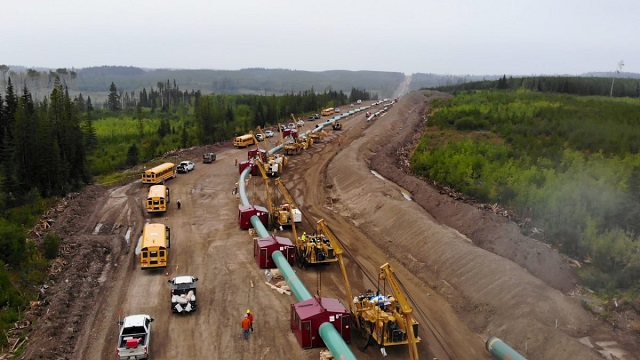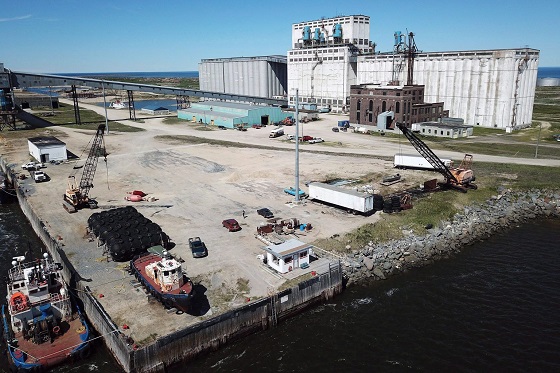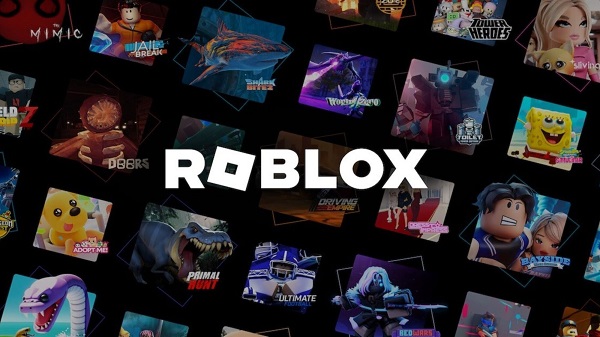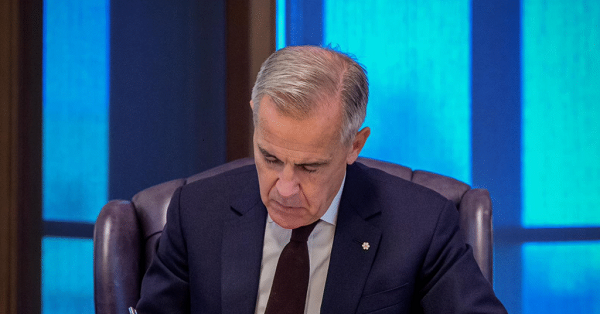Business
Counter tariffs not advised as Canada looks for answers in trade dispute

From the Fraser Institute
By Jock Finlayson
Trump’s trade war—an update from the front
August 1 marked another consequential day in President Donald Trump’s multi-front trade war involving virtually every country that does business with the world’s largest economy. In this case, Canada was again briefly in the spotlight, as the Trump administration announced a 35 per cent across-the-board duty on Canadian southbound exports—up from the 25 per cent levy unveiled a few months ago. The putative justification for this measure is Canada’s alleged failure to stem shipments of fentanyl, even though hardly any of the drug seizures reported by U.S. authorities have been traced to Canada.
The general tariffs being applied to Canada and other U.S. trading partners are separate from “sectoral” tariffs the Trump administration has imposed on all foreign suppliers of steel, aluminum, motor vehicles and certain copper products—with additional tariffs promised on imports of semi-conductors, pharmaceuticals and some other goods.
The president’s scattershot sectoral tariffs have done damage to a number of Canadian manufacturing industries that sell into the United States. Fortunately, however, the 35 per cent general tariff only covers Canadian exports that aren’t compliant with the Canada-U.S.-Mexico Trade Agreement (CUSMA). More than four-fifths of Canadian exports continue to enter the U.S. tariff-free. Amid the onslaught of U.S. tariffs, Canada is in a relatively favourable position, facing among the lowest average U.S. tariff rates of any country.
Over President Trump’s first 200 days in office, the multilateral global trading system has been upended. The U.S. has cast aside the precepts, principles and agreements that heretofore have strongly shaped American trade and foreign policies and embraced the core tenets associated with mercantilism. These tenets hold that trade deficits do profound economic harm to the countries that run them, and that the state should intervene forcefully to prevent domestic businesses and consumers from engaging in commercial exchanges with foreign suppliers of goods and services which they judge to be in their own interest.
President Trump’s brand of mercantilism heralds a dramatic increase in government interference in U.S. economic and business affairs. According to leading economists, it’s also setting the stage for a period of higher U.S. inflation—since the tariffs are paid by U.S. importers—which will reduce the real spending power of American households. The president’s approach to trade and industrial policy also promise to disrupt the global supply chains that many American industries have come to rely on.
On the other hand, America’s decisive turn toward mercantilism is likely to cause some foreign companies that do business in the U.S. to expand investments there and perhaps scale back their production and presence in other countries. Indeed, this is an explicit and often referenced goal of the 47th president. Canada is especially vulnerable to this risk, given that many Canadian industries are heavily dependent on the $30 trillion American market and plenty of Canadian firms already have operations in the U.S.
Finally, the president’s tariff barrage will generate substantial revenues for the cash-strapped U.S. Treasury—with some estimates suggesting $400 billion in new revenues, at least initially, albeit this must be set against a total federal deficit in the vicinity of $2 trillion per annum.
As Washington, D.C. cements its status as the world’s undisputed tariff capital, what options are available to Canadian policymakers?
First and foremost, they must strive to preserve the benefits that Canada has gained from the CUSMA, which is up for renegotiation in 2026. Prime Minister Mark Carney has signalled that this is a top Canadian priority. Of course, there can be no assurance the Trump administration will share this goal, but Canada must try. We should advance the argument that maintaining an integrated North American market, through a revitalized CUSMA, is the best way to strengthen the competitiveness of U.S. industries in the context of a fragmenting world and an increasingly fraught geopolitical backdrop.
Second, even as America’s sectoral tariffs continue to hurt some Canadian industries, Ottawa should steer clear of tit-for-tat tariff retaliation. Hiking Canadian duties on goods imported from the U.S. magnifies the negative economic impact of the president’s tariffs and is unlikely to prompt a near-term shift in U.S. trade policy.
Finally, Canadian negotiators should consider expanding the scope of discussions with the Trump administration to include “non-trade” issues that are important to U.S. policymakers. These could include enhancing North American security, expediting the development of Canadian critical minerals, increased collaboration on defence procurement, and moving toward greater strategic alignment vis-à-vis China—the only country with the capacity to challenge America’s position as the world’s most powerful nation.
Business
Budget 2025: Ottawa Fakes a Pivot and Still Spends Like Trudeau

It finally happened. Canada received a federal budget earlier this month, after more than a year without one. It’s far from a budget that’s great. It’s far from what many expected and distant from what the country needs. But it still passed.
With the budget vote drama now behind us, there may be space for some general observations beyond the details of the concerning deficits and debt. What kind of budget did Canada get?
Haultain’s Substack is a reader-supported publication.
To receive new posts and support our work, please consider becoming a free or paid subscriber.
Try it out.
For a government that built its political identity on social-program expansion and moralized spending, Budget 2025 arrives wearing borrowed clothing. It speaks in the language of productivity, infrastructure, and capital formation, the diction of grown-up economics, yet keeps the full spending reflex of the Trudeau era. The result feels like a cabinet trying to change its fiscal costume without changing the character inside it. Time will tell, to be fair, but it feels like more rhetoric, and we have seen this same rhetoric before lead to nothing. So, I remain skeptical of what they say and how they say it.
The government insists it has found a new path, one where public investment leads private growth. That sounds bold. However, it is more a rebranding than a reform. It is a shift in vocabulary, not in discipline.
A comparison with past eras makes this clear.
Jean Chrétien and Paul Martin did not flirt with restraint; they executed it. Their budgets were cut deeply, restored credibility, and revived Canada’s fiscal health when it was most needed. The Chrétien years were unsentimental. Political capital was spent so financial capital could return. Ottawa shrank so the country could grow. Budget 2025 tries to invoke their spirit but not their actions. Nothing in this plan resembles the structural surgery of the mid 1990s.
Stephen Harper, by contrast, treated balanced budgets as policy and principle. Even during the global financial crisis, his government used stimulus as a bridge, not a way of life. It cut taxes widely and consistently, limited public service growth, and placed the long-term burden on restraint rather than rhetoric. Budget 2025 nods toward Harper’s focus on productivity and capital assets, yet it rejects the tax relief and spending controls that made his budgets coherent.
Then there is Justin Trudeau, the high tide of redistribution, vacuous identity politics, and deficit-as-virtue posturing. Ottawa expanded into an ideological planner for everything, including housing, climate, childcare, inclusion portfolios, and every new identity category. Much of that ideological scaffolding consisted of mere words, weakening the principle of equality under the law and encouraging the government to referee culture rather than administer policy.
Budget 2025 is the first hint of retreat from that style. The identity program fireworks are dimmer, though they have not disappeared. The social policy boosterism is quieter. Perhaps fiscal gravity has begun to whisper in the prime minister’s ear.
However, one cannot confuse tone for transformation.
Spending is still vast. Deficits grew. The new fiscal anchor, balancing only the operating budget, is weaker than the one it replaced. The budget relies on the hopeful assumption that Ottawa’s capital spending will attract private investment on a scale that economists politely describe as ambitious.
The housing file illustrates the contradiction. The budget announces new funding for the construction of purpose-built rentals and a larger federal role in modular and subsidized housing builds. These are presented as productivity measures, yet they continue the Trudeau-era instinct to centralize housing policy rather than fix the levers that matter. Permitting delays, zoning rigidity, municipal approvals, and labour shortages continue to slow actual construction. Ottawa spends, but the foundations still cure at the same pace.
Defence spending tells the same story. Budget 2025 offers incremental funding and some procurement gestures, but it avoids the core problem: Canada’s procurement system is broken. Delays stretch across decades. Projects become obsolete before contracts are signed. The system cannot buy a ship, an aircraft, or an armoured vehicle without cost overruns and missed timelines. Spending more through this machinery will waste time and money. It adds motion, not capability.
Most importantly, the structural problems remain untouched: no regulatory reform for major projects, no tax competitiveness agenda, no strategy for shrinking a federal bureaucracy that has grown faster than the economy it governs. Ottawa presides over a low-productivity country but insists that a new accounting framework will solve what decades of overregulation and policy clutter have created. More bluster.
To receive new posts and support our work, please consider becoming a free or paid subscriber.
From an Alberta vantage, the pivot is welcome but inadequate. The economy that pays for Confederation, energy, mining, agriculture, and transportation receives more rhetorical respect in Budget 2025, yet the same regulatory thicket that blocks pipelines and mines remains intact. The government praises capital formation but still undermines the key sectors that generate it.
Budget 2025 tries to walk like Chrétien and talk like Harper while spending like Trudeau. That is not a transformation; it is a costume change. The country needed a budget that prioritized growth rooted in tangible assets and real productivity. What it got instead is a rhetorical turn without the courage to cut, streamline, or reform.
Canada does not require a new budgeting vocabulary. It requires a government willing to govern in the best interest of the country.
Haultain’s Substack is a reader-supported publication.
Help us bring you more quality research and commentary.
Business
Large-scale energy investments remain a pipe dream

I view the recent announcements by the Government of Canada as window dressing, and not addressing the fundamental issue which is that projects are drowning in bureaucratic red tape and regulatory overburden. We don’t need them picking winners and losers, a fool’s errand in my opinion, but rather make it easier to do business within Canada and stop the hemorrhaging of Foreign Direct Investment from this country.
Thanks for reading William’s Substack!
Subscribe for free to receive new posts and support my work.
Changes are afoot—reportedly, carve-outs and tweaks to federal regulations that would help attract investment in a new oil pipeline from Alberta. But any private proponent to come out of this deal will presumably be handpicked to advance through the narrow Bill C-5 window, aided by one-off fixes and exemptions.
That approach can only move us so far. It doesn’t address the underlying problem.
Anyone in the investment world will tell you a patchwork of adjustments is nowhere near enough to unlock the large-scale energy investment this country needs. And from that investor’s perspective, the horizon stretches far beyond a single political cycle. Even if this government promises clarity today in the much-anticipated memorandum of understanding (MOU), who knows whether it will be around by the time any major proposal actually moves forward.
With all of the talk of “nation-building” projects, I have often been asked what my thoughts are about what we must see from the federal government.
The energy sector is the file the feds have to get right. It is by far the largest component of Canadian exports, with oil accounting for $147 billion in 2024 (20 percent of all exports), and energy as a whole accounting for $227 billion of exports (30 percent of all exports).
Furthermore, we are home to some of the largest resource reserves in the world, including oil (third-largest in proven reserves) and natural gas (ninth-largest). Canada needs to wholeheartedly embrace that. Natural resource exceptionalism is exactly what Canada is, and we should be proud of it.
One of the most important factors that drives investment is commodity prices. But that is set by market forces.
Beyond that, I have always said that the two most important things one considers before looking at a project are the rule of law and regulatory certainty.
The Liberal government has been obtuse when it comes to whether it will continue the West Coast tanker ban (Bill C-48) or lift it to make way for a pipeline. But nobody will propose a pipeline without the regulatory and legal certainty that they will not be seriously hindered should they propose to build one.
Meanwhile, the proposed emissions cap is something that sets an incredibly negative tone, a sentiment that is the most influential factor in ensuring funds flow. Finally, the Impact Assessment Act, often referred to as the “no more pipelines bill” (Bill C-69), has started to blur the lines between provincial and federal authority.
All three are supposedly on the table for tweaks or carve-outs. But that may not be enough.
It is interesting that Norway—a country that built its wealth on oil and natural gas—has adopted the mantra that as long as oil is a part of the global economy, it will be the last producer standing. It does so while marrying conventional energy with lower-carbon standards. We should be more like Norway.
Rather than constantly speaking down to the sector, the Canadian government should embrace the wealth that this represents and adopt a similar narrative.
The sector isn’t looking for handouts. Rather, it is looking for certainty, and a government proud of the work that they do and is willing to say so to Canada and the rest of the world. Foreign direct investment outflows have been a huge issue for Canada, and one of the bigger drags on our economy.
Almost all of the major project announcements Prime Minister Mark Carney has made to date have been about existing projects, often decades in the making, which are not really “additive” to the economy and are reflective of the regulatory overburden that industry faces en masse.
I have always said governments are about setting the rules of the game, while it is up to businesses to decide whether they wish to participate or to pick up the ball and look elsewhere.
Capital is mobile and will pursue the best risk-adjusted returns it can find. But the flow of capital from our country proves that Canada is viewed as just too risky for investors.
The government’s job is not to try to pick winners and losers. History has shown that governments are horrible at that. Rather, it should create a risk-appropriate environment with stable and capital-attractive rules in place, and then get out of the way and see where the chips fall.
Link to The Hub article: Large-scale energy investments remain a pipe dream
Formerly the head of institutional equity research at FirstEnergy Capital Corp and ATB Capital Markets. I have been involved in the energy sector in either the sell side or corporately for over 25 years
Thanks for reading William’s Substack!
Subscribe for free to receive new posts and support my work.
-

 Carbon Tax6 hours ago
Carbon Tax6 hours agoCarney fails to undo Trudeau’s devastating energy policies
-

 Business2 days ago
Business2 days agoNew airline compensation rules could threaten regional travel and push up ticket prices
-

 Business2 days ago
Business2 days agoWill the Port of Churchill ever cease to be a dream?
-

 Censorship Industrial Complex2 days ago
Censorship Industrial Complex2 days agoMove over Soviet Russia: UK Police Make 10,000 Arrests Over “Offensive” Online Speech
-

 Digital ID2 days ago
Digital ID2 days agoRoblox to Mandate Facial and ID Verification
-

 Business2 hours ago
Business2 hours agoBudget 2025: Ottawa Fakes a Pivot and Still Spends Like Trudeau
-

 Daily Caller1 day ago
Daily Caller1 day agoTrump Gives Zelenskyy Until Thanksgiving To Agree On Peace Deal, With U.S. Weapons And Intel On The Line
-

 Business1 day ago
Business1 day agoI Was Hired To Root Out Bias At NIH. The Nation’s Health Research Agency Is Still Sick












